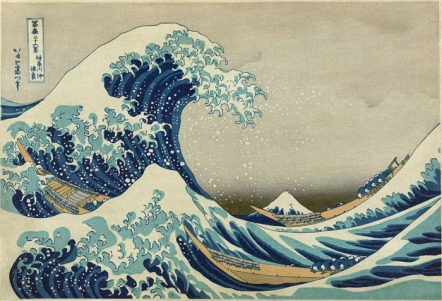The Geography of Japan
Around 400 million years ago, Japan was a peninsula, connected to the huge landmass known as Asia. Then, due to a chain of many volcanic incidents, it broke off, forming today’s Japan. Japan has a multitude of islands surrounding it, some of which are known as Hokkaido, and Kyushu. Japan’s culture and economy are heavily influenced from being an island.
Fish was a major source of food for the Japanese, due to the vast ocean surrounding it. Then, in the Yayoi period, the cultivation of rice was introduced, and became yet another vital food staple. Rice was abundant, mainly because of the mild and humid climate, perfect for growing rice. However, only a mere 15% of the land is flat enough for farming. The mountainous terrain not only made it hard to farm and travel, but it also separated the Japanese civilizations. There were several sectioned areas, that all differentiated in its ways, like their accent.
Japan is very-well situated, because of the fact that it was extremely hard to invade. The civilizations on the Asian mainland, like China and Korea, did not have this advantage. This not only kept out invaders, but also limited the amount of culture brought to Japan, due to its isolation. In addition, very few people immigrated to Japan, and there was very little blending of culture. Most of the ancestors of the inhabitants of Japan were from East Asia.
Japan has developed their own style and culture, but because Korea was rather closely situated to Japan, the Japanese learned many ideas through the Koreans. Both Chinese culture and Korean culture influenced the Japanese, but Chinese culture the most, due to Prince Shotoku. Japan’s name had actually been given to by the Chinese. Nippon, is what the Japanese call themselves, and means “land of the rising sun.” Even so, you can still see signs of Korea’s influence in the Japanese’s tools and technology.
However, there were some disadvantages to living in Japan. For example, there were frequent earthquakes, violent tidal waves, dangerous volcanoes, and furious hurricanes, and there was a very tiny 15% of the land good enough for farming. In addition, there were very small amounts of natural fuels, like coal and oil, were available. Even so, the rainy climate of Japan, and the numerous mountains made a gorgeous landscape; the land a beautiful spread of green. So, in Shinto, Japan’s traditional religion, nature’s beauty is clearly shown in many ways. Shinto is based on worships of and respect for nature and ancestors.
Japan’s geography has greatly influenced their culture and economy. Being an island, fish was very important. Japan was also incredibly hard to invade, and the culture was kept only mildly influenced by other civilizations, compared to others.
Important Places for the Japanese
Mt. Fuji
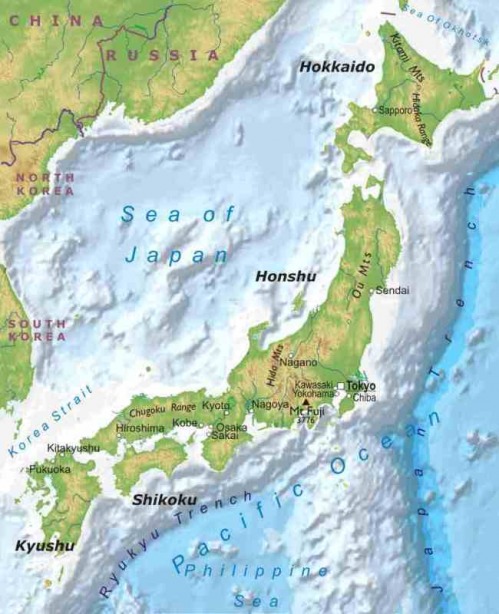
<------
Mt. Fuji is the tallest mountain in Japan, at 12,388 feet. It is also regarded as a sacred place. The towering peak is said to be the home of the fire god, and the forests below are said to be where the Shinto spirits dwell.
Kyushu
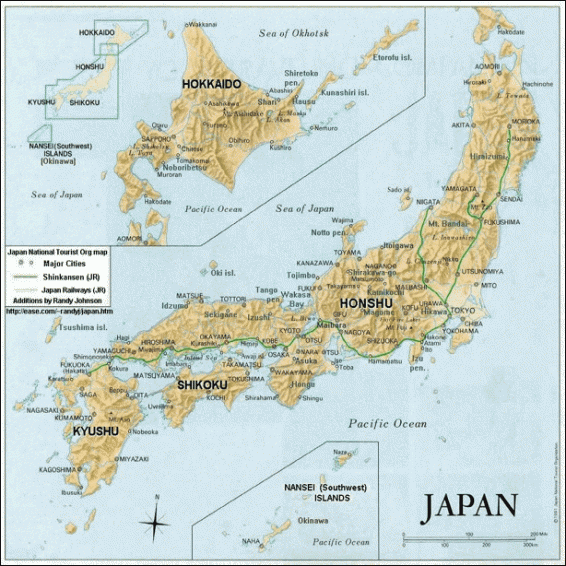
Kyushu is the third biggest island out of Japan's four. It is said to have been where the first habitants of Japan resided, and used to be called Sakaido.
------->
Kyoto
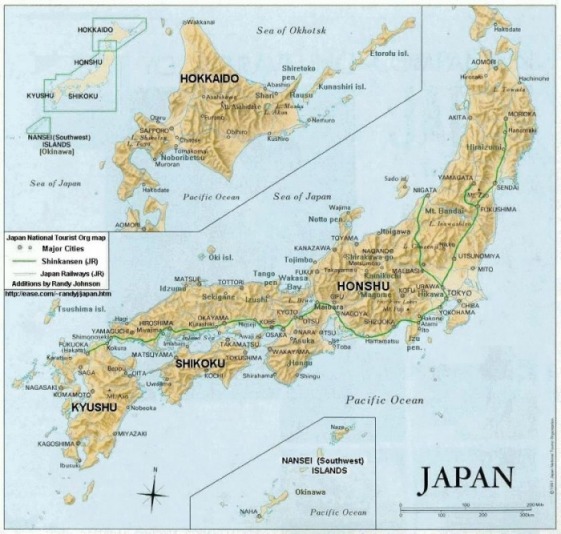
<--------- Kyoto was the city which the emperor resided it, and was Japan's capital until 1868, when it was moved to Tokyo. It has many temples, one of which is the Shimagomo Shrine. The Shimagomo Shrine is a very important Shinto temple, and many people visit it every year. It is labeled as one of the seventeen Historic Monuments of Ancient Kyoto.
Tokyo
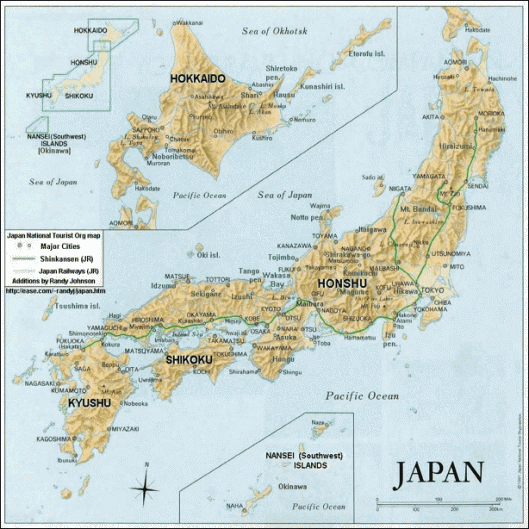
<-------- Tokyo was already a center of culture and politics, due to the fact that the shogun, Tokugawa Ieyasu, made Tokyo, called Edo at the time, his base for the military.
The Japan Trench
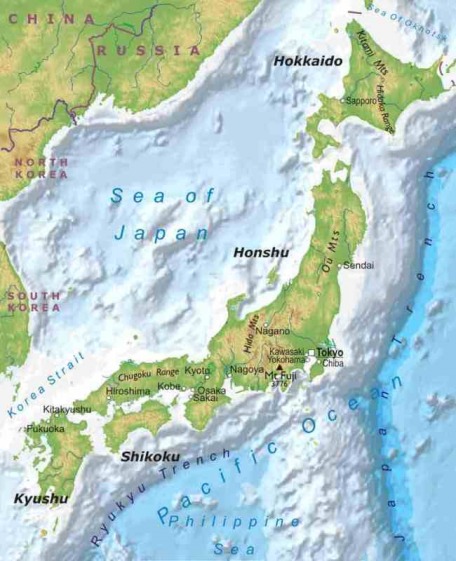
<--------- The Japan Trench is one of the major reasons Japan has so many earthquakes and tsunamis. Earthquakes in Japan are caused by the Pacific plate collides with the Asian Plate.
Nara Prefecture
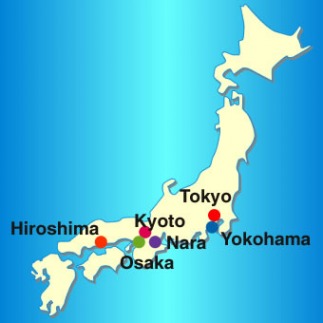
In Nara, several important temples are built there. Some of them include the Horyu-ji Temple, which was built by Prince Shotoku and is one of the earliest temples to worship Buddhist gods, the Kofuku-ji Temple, which is also one of the earliest Buddhist temples, and the Todai-ji Temple, which is the world's largest wooden building. It also has the biggest Buddhist statue in the world. These temples all allowed for more Buddhism to be spread throughout Japan, especially the Horyu-ji Temple and the Kofuku-ji Temple. The Nara prefecture is an area where there are deer wandering about. You can actually buy small cookies to feed the deer, so it has become a popular tourist attraction today.
<---------
<---------
Volcanoes of Japan
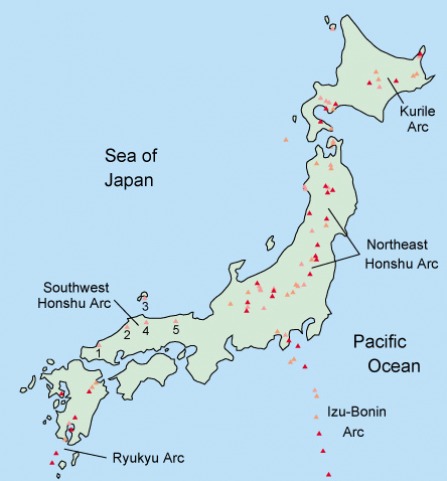
The volcanoes shown here are all active. Because of these volcanoes, the Japanese have a fire goddess which they worshiped.
